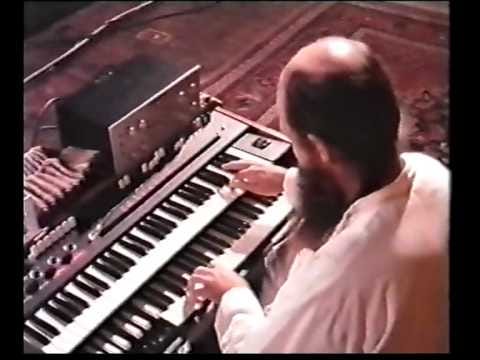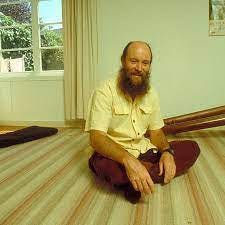Terry Riley, usually described as a 'minimalist composer' or some similar combination of words, turned 88 on June 24, 2023. Along with Lamonte Young and Steve Reich, Riley is generally credited with launching the compositional style known as minimalism, but his work is in some ways fundamentally different from the work of his contemporaries and his influence continues to this day.
One of the building blocks of minimalism is the repetition of musical phrases or ideas. These repetitions change slightly over time, sometimes phasing over each other and creating new, kaleidoscopic patterns, rhythmic patterns, overtones, harmonics. Sometimes patterns are stacked on top of one another, at others melodic material is presented in the foreground of such washes of patterned sound. It's something like object oriented computing adapted to musical composition.
Through repetition the sound itself becomes invested with meaning to the listener. The music can function as a mantra, to focus thought, or it can become a sacred sound, a prayer, a chant that is offered to the listener, and by extension, the universe.
But Riley, a keen student of John Cage, routinely injects improvisation into his performances and compositions. So the electronic organ or synthesizer or saxophone tape loops become a programmed part of a live performance that is subject to change, to the whims of the performer, the engagement of the audience, the weather, or a million other circumstances. Terry Riley's music is a living organism, teeming with life, reproducing, repeating, creating, swelling, attacking, decaying, breeding, falling and rising. But above all, it is always changing no matter how quickly or slowly.
It's the sound of the universe that is always there, going unnoticed most of the time, humming away until suddenly it edges its way into the periphery of your world and insinuates itself, gradually becoming more ecstatic. In the sixties Riley played improvisational concerts under the moniker Poppy Nogood that went all night, creating new material on top of the compost of his tape loops. The exchange of energy between performer and audience is anticipatory of the idea behind both rave culture and the post-EDM chill out room. According to Magnet Magazine's 2001 profile on Riley by Mitch Myers: "British DJ Mixmaster Morris keeps an extensive library of Riley recordings and has long held him as one of the great innovators in contemporary music. '(Riley’s) use of electronic modulation in a live context was 30 years ahead of the field,' says Morris."
https://magnetmagazine.com/2022/01/27/o-say-can-you-c-terry-rileys-great-american-life/
Rainbow in Curved Air, the result of a Columbia recording contract that Riley signed on the strength of his minimalist masterpiece "In C," recreated Riley's Poppy Nogood loft concerts with professional studio techniques and state of the art electronics. “There was a sensibility that was changing in the late ’60s,” Riley told Myers. “It would have been hard to create these records five years earlier. The Curved Air sessions were the first recording sessions made on an eight-track machine at CBS. They wheeled it in, it was brand new and nobody had even used it yet.”
A Rainbow In Curved Air was just as influential as In C, but whereas In C created a paradigm shift in terms of composition and performance in general, A Rainbow In Curved Air was all about electronics and technology. Electronics in the production of sound, then used to enhance and manipulate that sound. Again, Riley is improvising all around the loops and tapes, and his talent as a musician, playing keyboards, piano, saxophone, and other instruments is often overlooked by those who see him mostly as a composer.
In the early seventies Riley was working with the same ideas, composing and performing music for independent films. The recording Les Yeux Fermes/Lifespan contains two such works. The two lengthy tracks for Les Yeux Fermes sound more like the trance-inducing work of Sun Ra or an experimental rock band of the period than the strict minimalism of "In C."
So many ideas were floating around at that time, just beginning to converge in ways that reverberated throughout the next six decades: early ideas about psychedelics and brain patterns, neurochemistry was in its infancy as well as Eastern ideas about meditation, trance, and more. In 1975 a woman named Marilyn Ferguson began publishing a newsletter about developments in neuroscience and brain research, and she began to notice that a lot of her readers were interested in various fringe developments that were still off the map, but which appeared to be coalescing towards some new kind of world view. She dubbed this 'The Aquarian Conspiracy' and published a book by the same title in 1980. Her book became a framework for the development of the New Age Movement of the eighties.
The music that Riley and his cohorts were composing, performing, and recording, were part of a perceived new age in music and electronic music in particular. That seems to gel with the ideas that Ferguson was encountering, the rapid development of the neurosciences, interest in psychedelic drugs and experiences, and interest in alternative spiritual systems. Columbia marketed A Rainbow In Curved Air as part of its Masterworks contemporary classical series along with Wendy Carlos' Switched on Bach and Morton Subotnik's composition Touch. The electronic age had arrived.
Riley hasn't received the kind of recognition that some of those he has influenced, including Steve Reich and Philip Glass, have had. Following his CBS deal his music was released on independent labels. Part of this can be traced to the fact that he left New York to study with classic Indian music master Pran Nath. Though he returned to the U.S. within a year, he went to California rather than New York City. Another reason may be that he is less focused on articulating his legacy and more intent on simply creating and helping while he can:
“When I walked away from New York, I knew fame wouldn’t have given me any happiness if it weren’t based on a musical choice. Pran Nath said, ‘Just enough fame to keep doing your work is enough,’ and I thought that was good advice. I feel terrifically lucky every day I get up and give thanks for what’s happened. What really makes me sad is to see young musicians who are hopeless about their situations. My advice is put it all into the music. That’s the only thing you can do, because you don’t know what kind of hand fate is going to extend you. At least your own soul is going to be getting some feedback.”
Things may be changing, though, because Riley is perfect for the time. He has spent his entire career participating in --creating as he went-- the culture of sound, tape, technology, and time that we now take for granted. His influence extends beyond minimalism and into electronic music, rock and roll, ambient, trance, rave culture, and more. Pete Townshend was moved, after hearing A Rainbow In Curved Air, to create the tape loop backgrounds to The Who's "Won't Get Fooled Again" and especially "Baba O'Riley," which he named after his guru, Maher Baba and Terry Riley. Records like Mike Oldfield's Tubular Bells and Jean Michel Jarre's Equinoxe were influenced in some ways by Riley's work.
Or consider the hip hop remix-style tape manipulation on Music For the Gift, for which Riley recorded each member of Chet Baker's quartet performing Miles Davis' "So What" and then subjected them to his time lag accumulator process. The results are stunningly modern even though the piece was created in 1963.
Riley's music took a turn towards North Indian music as a result of his work with Pran Nath. Works such as Persian Surgery Dervishes and Shri Camel use keyboards and a sixteen track studio to create music that unfolds slowly and is capable of creating the kinds of micro tones that North Indian music takes for granted. But it is presented in a setting of minimalism, modal jazz, and improvisation.
Riley's music never sounds dated because it mimics the structure of our brains, our way of looking at the world. "In C" is the most important composition of our time, because it helped to progress the idea of the democratization of music--that music can be created by people who are not trained musicians. It's always there and familiar, but it's also different every time. Maybe the perfect metaphor for our life, or our lives, or whatever you think constitutes the totality of our travels through space and time, the arc of everything that has ever existed up until this point.
New Directions in Music is written by a single real person. It is not generated by AI. Please help spread good content by reading (Thank you!) and sharing this post with a music loving friend. If you like what you see, please sign up for a free subscription so you don’t miss a thing, or sign up for a paid subscription if you can.



